

KEYSTONE PENNSYLVANIA
EXPLORING ANCIENT CULTURES AND MODERN CONNECTIONS
EDITOR-IN-CHIEF
EMMANUELLE KRAMER

MANAGING EDITOR
TRACI DOUGHERTY
LAYA SUBRAMANIAN
CONTENT DIRECTOR
EMMANUELLE KRAMER
ART DIRECTOR
ARLO DALGARNO PLATT
CONTRIBUTING LEADERSHIP
KARIN SUZADIL
TRACI DOUGHERTY
CONTRIBUTING WRITERS
ABIGAIL NICOLEA
BRANDON LI
BRIAN LESTER
CHARLOTTE MARLOWE
CLAIRE WHITLOCK
ELIZABETH BOOTH
ISABELLA XIE
LAYA SUBRAMANIAN
MARISSA MOLITERNO
MAYA GAVRIN
NATALIE STOICA
REBECCA ZHAO
REME CASTELLON
SABRINA BAUER
VIOLET ROSENCRANCE
Investigate the transactions of Tablet 343, revealing Roman supply chains and military-civilian partnerships.
SILVER AGE AUTHORS
Unravel the poetic brilliance of the Silver Age Authors, whose bold, satirical, and epic writings shaped Latin literature for generations.
Dive into Roman aquatic traditions, where military training and daily life meet in the Tiber River and beyond
Reveal the tragic tale of Althaea in The Mother of Meleager, as a mythic prophecy and maternal grief intertwine
Meet the student leaders behind the PAJCL discover their roles, favorite Latin moments, and why they believe classics still matter
Decipher the secret chemistry of Roman Concrete that helped ancient architecture survive millennia and may shape sustainable building today
FROM THE EDITOR
Dear Readers,
As the cold of winter begins to melt, we have been working on this cozy issue of the Keystone!
IHere, you’ll go from the interesting history of the Silver Age to the character of Feronia herself. You’ll encounter philosophers who shaped modern thought, myths retold through musicals, and imagination through space There is someone for everyone in this issue-- whether you’re a sports lover, scholar, or creative who loves a good pun.
This issue reflects the incredible work of our Pennsylvania Junior Classical League participants You brought worlds to life, exploring new terrain with your ancient words.
Thank you to all our contributors, artists, editors, and supporters who helped bring this issue to life And to every reader: may you find something in these pages that makes you laugh, think, or see the ancient world in a new light.





EDITOR-IN-CHIEF
Contributors’ image: Club Initiation, Harriton High School, photo by Catharine Fan.
Editor’s Letter image: Latin Club Meeting, Phoenixville High School.

Explore musical evolution in Epic: The Musical, comparing ancient instruments and poetic rhythms to modern-day mythic musicals
Celebrate ancient satire and discover how jokes from Rome to Reddit prove laughter never ages
and the Edge of
into
FROM THE TREASURER
I’m excited to share some information about my role within the Pennsylvania Junior Classical League.
My name is Mrs Karin Suzadail, and I am the Latin teacher at Owen J Roberts High School in Pottstown, PA In addition to my teaching duties and work as the chapter sponsor for the OJR JCL, I also serve as the Constitution Chairperson and the Treasurer for PAJCL. During the State Convention, I also work as the Olympika Chairperson That means my year is pretty busy, especially during the spring
As Constitution Chairperson, I make sure that our constitution and bylaws are in line with those of the National Junior Classical League If changes need to be made, I ensure that we follow our procedures to incorporate those changes at the convention. Spring is also the season for PAJCL officer elections, and I work with our student Parliamentarian to communicate information about the election and hold the election at the convention
As the Treasurer for PAJCL, I keep an eye on all things financial. I track dues and convention payments from the various chapters and maintain records of all financial transactions I collate all this information and work with our accountant to file the PAJCL tax return with the IRS each year I work with the PAJCL State Chairperson as a co-signer of all the checks written, ensuring strict oversight of expenditures.

One of the fun parts of my year is at the Convention as the Olympika Chairperson I arrange all the track and field competitions at Penn State and work with a former Penn State track coach and one of the PSU trainers, who is also a professor in their College of Health and Human Development (be sure to say hi to Mr Whittaker and Dr Vairo when you are at the track this year!).
When I am not working on lessons, grading, or my OJR JCL or PAJCL tasks, I enjoy gardening, cooking, skiing, and traveling.

PAJCL STATE TREASURER

KEYSTONE
SUBMISSION DATES:
AUTUMN - DEC 6 WINTER - FEB 7
SPRING - MAR 28 CONVENTION - MAY 30
KEYSTONE
SCHOOLS IN THIS ISSUE:
CONRAD WEISER HIGH SCHOOL
HARRITON HIGH SCHOOL
OWEN J. ROBERTS HIGH SCHOOL
PHOENIXVILLE HIGH SCHOOL
UPPER DUBLIN HIGH SCHOOL
NORTH ALLEGHENY HIGH SCHOOL
IVYMIND
CONTENT IDEAS:
PHOTOS
CHAPTER NEWS
RESOURCES
ARTWORK
GAMES
EVENT RECAPS

Io...Io...Io
Upper Dublin School District



Latin students from across Pennsylvania came together to revel in the joyful chaos of Saturnalia, hosted this year at Sandy Run Middle School Ten schools joined the celebration, turning tradition into hands-on fun with a day full of creativity, competition, and camaraderie
The event featured a wide range of activities inspired by Roman culture and the spirit of Saturnalia.
Students raced in thrilling currus (chariot) competitions, acted out hilarious and myth-filled skits, and brought classical stories to life through impromptu art challenges The Certamen arena was alive with buzzing brains and fast answers, while a Cookie Contest (complete with Saturnalia flair) brought out the best in both bakers and taste-testers Upper Dublin students stood out once again, earning top honors in Certamen and wowing the crowd with their performances and artistic flair.
The festive atmosphere, complete with laughter, laurel crowns, and good-natured mischief, made for a memorable day that blended ancient tradition with modern student enthusiasm
Key Highlights:
Certamen Champions: Upper Dublin took 1st place in the advanced division
Cookie Contest: Saturnalia-themed treats earned top marks for both taste and creativity.
Mythology Skits: Crowd favorites included a togawrapped musical retelling of Apollo and Marsyas
Chariot Races: Team Auriga Maximus narrowly edged out the competition in a photo finish
Impromptu Art: Quick-draw myth scenes brought out serious talent (and some serious laughs).
We can’t wait to welcome everyone back for more Saturnalia fun next year Io Saturnalia! 10
Saturnalia

Latin students from regional high schools gathered at Harriton High School on Friday afternoon, December 13th, to celebrate the ancient Roman winter solstice festival, Saturnalia, which in ancient times ran annually for one week, December 17 to December 24. The Saturnalia was also a harvest festival in honor of the agricultural god, Saturn. The Saturnalia was a time of merriment and gift-giving, and even Roman slaves got a week’s week-long vacation from their duties.
The format was adjusted for the challenging Certamen trivia challenges by allowing students from different schools to play on the same team. The team that included Radnor students Esme Luvaas and Anderson Forbes clinched victory, while the team that included Mackenzie Rose, Anrui Xu, and Mathilde Lesage Rueda made it to the final round.
Another highlight of the evening was the acting out of different types of Roman processions. After a very informative PowerPoint presentation explaining ancient customs and technical vocabulary, another student performed a wedding procession. Other processions included a triumphal parade and a funeral procession. The students remarked that they learned a lot and enjoyed connecting with Latin students from other schools. Io Saturnalia



HUMOR & LIFESTYLE
GAME: WORDSEARCH
Test your knowledge of Gladiator II with this exciting word search! Explore the epic world of gladiators, battles, and Roman intrigue Can you find all the hidden words and prove your loyalty to the Empire?
1.This phrase, spoken by Brennus, means "Woe to the vanquished!" (9 letters)
2 Ovid wrote that this overcomes all things (17 letters)
3 A grand arena in Rome where gladiators fought (9 letters)
4 The title of a famous movie about a Roman warrior (9 letters)
5 A famous Roman poet who wrote Metamorphoses (4 letters)
6.The Gallic leader who mocked the Romans after sacking their city. (7 letters)
7.An ancient Roman festival celebrating Saturn (10 letters)
8 A Latin word meaning "Roman" (7 letters)
9 A title used for Roman emperors, meaning "commander" (9 letters)
10 The city of brotherly love, home of the Liberty Bell (12 letters)
11 Roman priests who interpreted omens from the flight of birds (7 letters)
12. A tragic figure in the underworld who was doomed to roll a boulder forever. (8 letters)
13 A mythical king punished by never being able to drink or eat (8 letters)
14 A place where you can watch films Romans might have called it Cinema Romana! (6 letters)
15 A U S state known for its famous groundhog (13 letters)

Maya Gavrin is a 10th-grade Latin student at Harriton High School and is an avid Certamen player and explores her fascination with mythology
TAKE THE POLL: AENEID
What sounds more appealing: being a powerful goddess, a fearless warrior, or the ruler of a thriving city? This poll invites Latin students to reflect on which character from the Aeneid they connect with most—and why they see themselves in that role.
Isabella Xie is a senior at Upper Dublin High School with plans to pursue a career in nursing In her free time, she enjoys listening to music and spending quality time with her beloved cat

Natalie Stoica is a first year Latin Student at Conrad Weiser High School This year was her first year taking a Latin course, and she plans to continue throughout high school In addition to taking Latin classes, Natalie is involved in her school’s Key Club, as well as being involved in the school’s art club and taking art classes.
Marissa Moliterno is a senior Latin student and is a member of Owen J Robert’s high school’s Latin Club She has been acknowledged as a Latin reward recipient in the past and looks forward to persuing Latin more in college



HUMOR & LIFESTYLE
CERTAMEN: STREET-STYLED
As we celebrate National Pickle Day, these Certamen themed questions explore the culinary, cultural, and practical significance of pickling in Roman life, from the kitchens of villas to the feast tables of festivals and the supplies carried by soldiers
Question 1: Romans preserved many foods, including cucumbers, in brine or vinegar What Latin term refers to "brine" or "salt water"?
B1: Name a Roman seasoning that combined fermented fish and salt, often used alongside pickled foods
B2: What was the Latin term for a kitchen, where pickling jars might have been stored?
Question 2: Roman soldiers valued pickled vegetables for their long shelf life What famous wall built by Roman soldiers in Britain might have required such provisions?
B1: Hadrian’s Wall was built during the reign of which emperor?
B2: What was the primary purpose of Hadrian’s Wall?
Question 3: Romans enjoyed fermented foods at festivals During what December festival might pickles have been part of a feast celebrating equality and abundance?
B1: What Roman holiday celebrated the beginning of the harvest season and honored Ceres?
B2: Ceres was the Roman equivalent of what Greek goddess?
Question 1: Romans preserved many foods, including cucumbers, in brine or vinegar What Latin term refers to "brine" or "salt water"?
B1: Name a Roman seasoning that combined fermented fish and salt, often used alongside pickled foods
B2: What was the Latin term for a kitchen, where pickling jars might have been stored?
Question 2: Roman soldiers valued pickled vegetables for their long shelf life What famous wall built by Roman soldiers in Britain might have required such provisions?
B1: Hadrian’s Wall was built during the reign of which emperor?
B2: What was the primary purpose of Hadrian’s Wall?
Question 3: Romans enjoyed fermented foods at festivals During what December festival might pickles have been part of a feast celebrating equality and abundance?
B1: What Roman holiday celebrated the beginning of the harvest season and honored Ceres?
B2: Ceres was the Roman equivalent of what Greek goddess?
Question 4: Pickling was an important method of preservation What Roman storage vessel, often buried underground, was used to keep food like pickles cool and fresh?
B1: What Roman invention, often found in villas, helped maintain temperature control for storage?
B2: Name the Roman structure used for bathing that might also feature areas for food storage.
Question 5: Roman banquets featured a variety of foods What Latin word, meaning "relish" or "sauce," was used for small side dishes that complemented meals, like pickled vegetables?
B1: Name the Roman cook who wrote recipes that included pickling
B2: In what century did Apicius compile his cookbook De Re Coquinaria?packed rations?
Question 6: Roman merchants traded pickled goods along famous routes What was the name of the main Roman road connecting Rome to Brindisi, facilitating such trade?
B1: Name the Roman province where olives, often pickled alongside cucumbers, were heavily cultivated
B2: What body of water facilitated the trade of pickled goods from Roman provinces?
Question 7: Roman cuisine was heavily influenced by Greek culture. What Greek author, famous for writing about gastronomy, might have inspired Roman pickling techniques?
B1: What is the title of Athenaeus's work, a compilation of culinary knowledge?
B2: Which famous Greek doctor promoted the health benefits of pickled foods and influenced Roman medical practices?
Question 8: Romans used vinegar not only for pickling but also as a refreshing drink for soldiers. What was the name of this vinegar-based drink?
B1: Posca was often consumed by what group within the Roman military?
B2: What was the primary weapon carried by a Roman legionary, complementing their provision-
To defend the Roman frontier and control movement between Roman Britain and the Picts
Sabrina Bauer is a senior at Upper Dublin High School and a passionate leader in various activities. She serves as copresident of the Latin Club, vice president of the Pennsylvania Junior Classical League Board, Treasurer of the Library and Media Club, and Secretary of the Archery Club.

CLUB UPDATES
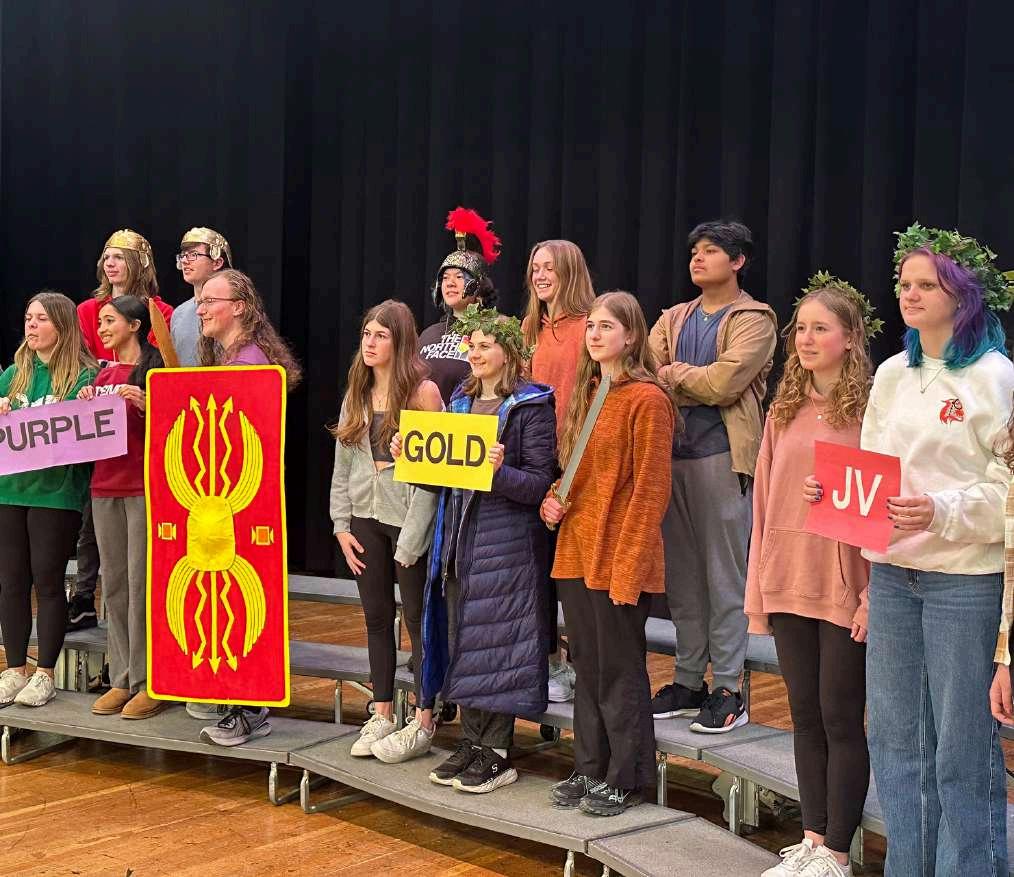
ACROSS THE STATE
As the winter season settles in, PAJCL chapters across the state continue to thrive with energy, creativity, and a strong sense of community From festive events to impactful service projects, these chapters are demonstrating the lasting significance of classical studies in today’s student experience.

The newly-founded Winchester Thurston School chapter consists of about a dozen members The chapter has finally begun to take form and has already met up a number of times, planning and discussing future ideas We are excited to be a part of PAJCL and are looking forward to many fun activities in 2025, hopefully capping it off with a trip to the convention and Penn State. We were anxiously awaiting the return to school to get started working on all the projects, competitions, and essays for the convention, along with other events and meetings, including a trip to the movie theaters to see Gladiator 2. Thanks for welcoming us and here’s to a great 2025!

Conrad Weiser has had a busy start to the 2024-2025 school year. Some of the year’s highlights so far include pumpkin painting, Latin Fall Fest at Upper Dublin, a field trip to the UPenn Museum followed by lunch at Reading Terminal market, entered the school’s door decorating contest, feasted on latkes, and enjoying ice cream cake and Latin caroling at Saturnalia. We’ve also had weekly meetings where we relax and watch Percy Jackson, play the award-winning video game Hades, and practice mythology via bingo With the new year approaching, CW students can look forward to the annual edible mosaic contest as a welcome activity for second semester Latin students



TRADE, TACTICS, AND TABLET 343

Vindolanda tablet 343 records a letter sent by Octavius to his brother Candidus, in which they discuss large transactions of sinew, grain, and hides These resources, with vast quantities and prices, perhaps supported the Roman fort of Vindolanda, specifically mentioned on the reverse side of the tablet Octavius and Candidus report that they purchased 100 pounds of sinew and 5000 modii (which is about 11,636 gallons) of grain ears (spicae) Besides, Octavius sold 170 hides, sought more, and stored 119 modii of bracis, a cereal that was used in Celtic beer, with less strict discipline over alcohol in Roman camps.
KEYSTONE
Octavius describes paying a 300-denarius down payment for the grain, followed immediately by another 500 denarii, coming out to a total of at least 800 denarii As one denarius was approximately a soldier's Roman daily wage, this is a significant amount of money Nevertheless, 800 denarii for 5000 modii comes out to the impossibly low 0 16 denarii per modius, when two denarii per modius was the typical rate in Rome at the time This indicates that perhaps the 500 denarii is only an advance payment of a larger sum, reaching 10,000 denarii, considering as well the minimal effect chaff has on grain weight and price
Octavius refers to skins located at the town of Cataractonium, some 60 miles to the south of Vindolanda. With tanneries discovered at its modern-day archaeological site, this logically fulfills a supply chain. There has been much debate surrounding Octavius – was he a civilian businessman or a supply officer in the army? In support of the army hypothesis, Octavius describes an imperfect sale of hides to "a messmate (contubernalis) of our friend Frontius," with the connotation of contubernalis providing a strong probability of army involvement The use of "adsignarem" (allocate) rather than overt selling terminology is also consistent with military terminology. Octavius demands to exchange hides for cash, a specification implying a generous army favor, but excessive terminology for a businessman.
Conversely, evidence for the entrepreneur theory shows up when Octavius states: "Frontinius Iulius has for sale at a high price the leatherware which he bought here for five denarii apiece." This entrepreneurial interpretation is reasonable if Octavius is observing competitive prices. If Frontinius were military, profiteering on military supplies would be against Roman discipline and thus, logistical problems would ensue It could be more probable in this case that Octavius, as an entrepreneur, is observing competitor action, which is relevant to his enterprise The intricacies of such transactions and references to military and mercantile contexts demonstrate the interface between civilian enterprise and military logistics in Roman society. Although both analyses of the position of Octavius remain inconclusive, Vindolanda tablet 343 nevertheless provides an intriguing glimpse of Roman military supply mechanisms

BUSINESS & SPORTS
DID THE AVERAGE ROMANS KNOW HOW TO SWIM?
Most people today know how to swim safely with the 5 basic skills of swimming 80% of American people claim they know how to swim, but only 56% can perform all of five skills. The other 54% either can not swim or don’t know all of the basic swimming skills Through letters, literature, and archaeology, scientists and archaeologists were able to discover the Romans’ love of swimming.
For the Romans and the Greeks, swimming was found to be an art form. It was used as part of martial training. They knew how to swim on their front, back, and even front crawl. One modern swim style they knew was the breaststroke The purpose of swimming was to use it during battles, preventing drowning, the dangers of shipwrecks, etc Swimming was traditionally for young Roman boys and was widely practiced in the Tiber River near Campus Martius. Other accounts state that some women know how to swim. The lower-status Romans did not typically learn how to swim



Referring to military training, some of those methods have transformed into modern-day military training. Modern Marines are trained in many different levels and situations and have to prove their ability to swim They will have simulators to have the pool to imitate weather conditions on the waters. The Marines are trained to be on water, land, or in the air For the Coast Guard, they are trained mentally and physically during the boot camp They will have to swim in uniform with some weights on. They need to know freestyle, backstyle, and breaststroke.
Roman military training was mostly during the summer months and would include swimming The only training for swimming is when there is any body of water near the camp, or if there was a natatio or swimming pool in a large bath building They wanted Roman soldiers to be prepared for any situation, hostile territory, and terrain Also, there was little distinction between Roman marines, army, and navy. The army would be on the ships ready to cross over and fight hand to hand on enemy ships
Roman boys, especially from wealthier families, were expected to learn literacy and swimming. The phrase “litteras et natare” (“to read and to swim”) was commonly used to describe the essential skills of an educated citizen
Swimming was seen as a practical survival skill, a form of exercise, and even a way to build discipline and character.
Public bathhouses, known as thermae, often included large open-air pools specifically for swimming, called natationes These were separate from the heated baths and were used for actual swimming, not just lounging
Wealthy Romans sometimes had their own private swimming pools, or piscinae, in their countryside villas.
OFFICER SPOTLIGHT
ROHA HERIAL
President
WHY DID YOU TAKE LATIN?
I STARTED STUDYING LATIN IN 7TH GRADE, WHICH WAS THE FIRST YEAR YOU CAN TAKE IT IN OUR SCHOOL DISTRICT I KNOW IT'S CLICHE, BUT I'D BEEN OBSESSED WITH GRECO-ROMAN MYTHOLOGY AND ANCIENT HISTORY (SPECIFICALLY ANCIENT EGYPT AND ROME) SINCE ELEMENTARY SCHOOL, AND LATIN INTRIGUED ME BECAUSE OF ITS CONNECTIONS TO BOTH OF THOSE.
WHAT’S YOUR TOP MEMORY?
MY FAVORITE MEMORY FROM PAJCL LEADERSHIP WAS MANAGING THE PRETZEL AND MARSHMALLOW BUILDING EVENT AT SANDY RUN MIDDLE SCHOOL'S FALL FEST THIS YEAR




Vice President

EMMANUELL KRAMER
Editor

WHY DID YOU TAKE LAT
I LIKED THE IDEA OF LEARNING THAT'S THE FOUNDATION FOR O LANGUAGES THE LATIN CLUB H ACTIVITIES LIKE PUMPKIN PAINT MYTHOLOGY TRIVIA, SO HAVING WAS ALSO MOTIVATION.
WHAT’S YOUR TOP MEM
THE MURDER MYSTERY PARTY D OF MARCH MEETING
KEYSTONE
CHRISTOPHER CHANG
Secretary
WHY DID YOU TAKE LATIN?
IT SEEMED INTERESTING AND MY SISTER TOOK IT
WHAT’S YOUR TOP MEMORY?
MY FAVORITE LATIN MEMORY IS RUNNING SATURNALIA


SOHUM BANDYOPADHYAY
Parliamentarian
WHY DID YOU TAKE LATIN?
I AM NOT PARTICULARLY INTERESTED IN STUDYING JUST ANY ONE LANGUAGE, BUT RATHER I ENJOY STUDYING HOW LANGUAGE ITSELF IS CONFIGURED AND COMES ABOUT. THIS IS WHAT DREW ME TO LATIN, BECAUSE IT IS THE PROGENITOR OF MANY PREVALENT MODERN LANGUAGES; UNDERSTANDING THE MECHANICS OF LATIN REVEALS THE INNER WORKINGS OF LANGUAGE ITSELF THE LANGUAGE ALSO INTERESTS ME BECAUSE IT CARRIES THE RICH HISTORY OF THE ROMAN EMPIRE, ONE OF THE GREATEST CIVILIZATIONS THE WORLD HAS EVER SEEN.

WHAT’S YOUR TOP MEMORY?
MY FAVORITE MEMORY FROM PAJCL LEADERSHIP WAS MANAGING THE PRETZEL AND MARSHMALLOW BUILDING EVENT AT SANDY RUN MIDDLE SCHOOL'S FALL FEST THIS YEAR

EXCELLEMCE THROUGH CLASSICS


HISTORY & MYTHOLOGY
AUTHORS OF THE SILVER AGE
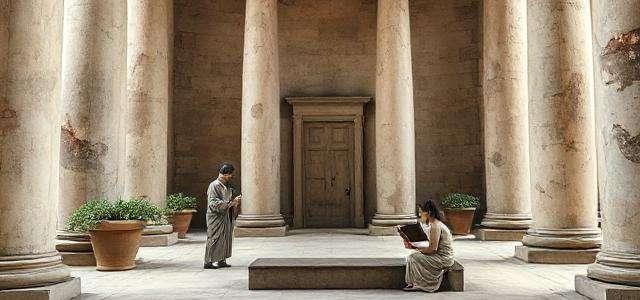
“The authors of the Silver Age left a lasting legacy, shaping poetry and literature for generations to come.”
The Silver Age is a period full of Latin literature, and it happened from around 18 AD to 133 AD There were a lot of authors during this age, including Petronius, Valerius Flaccus, Statius, Silius Italicus, and Juvenal. Each of these authors created important works during this time, and some of them were saved Petronius was alive from 27-65 AD.
His most notable work is the Satyricon, which was a satire that portrays the journey of a man named Encolpius as he travels the Mediterranean, and it delves into Roman life The Satyricon was written around 63-65 CE Petronius was believed to have killed himself in 65 AD. Valerius Flaccus is another known author at this time. He lived from 45 AD to 90 AD.
His most famous work is the Argonautica, which is an epic poem talking about Jason's journey trying to get the golden fleece He died around 90 AD Another poet is Statius, who lived from 45-96 AD His most famous works are Thebaid and Achilles. Thebaid is an epic poem about Oedipus and his sons and Theseus's rise to power Achilles is an epic poem that was unfinished but contained the early life of Achilles
Another author at the time was Silius Italicus, who lived from 26 AD to 101 AD. His most notable work is the epic poem Punica, which delves into the Second Punic War. Punica’s themes are similar to those of the Aeneid Another author is Juvenal, who lived from 55 AD - 138 AD He is best known for the satires that he wrote. The satires talk about all the corruption in Rome All these authors created works that can be reviewed today and had a lasting effect on poetry after the Silver Age
Violet Rosencrance is a Latin IV student at Owen J Roberts High School and serves as vice president of her school's Junior Classical League. She competes in Latin League with her classmates and is involved in nine other clubs She has also been a member of the tennis and track and field teams since freshman year.

HISTORY & MYTHOLOGY

THE MOTHER OF MELEAGER
I am the ghost of Althaea, Meleager’s own mother. And I am the reason for his death. After I killed him, I committed suicide. But this story doesn’t start when I killed him It doesn’t start in the Calydonian Boar Hunt It started many, many years ago, when my son was just a newborn...
My son was only seven days old when the Fates came to visit my castle We had a warm fire going, and I was sitting, tending to the flames, when the Fates arrived What they told me changed my life, and my son’s, forever. They predicted that Meleager would only live until a certain piece of wood that was burning in the hearth would be consumed by fire I panicked, doused the piece of wood, and hid it where I knew it would never be harmed. But my actions were in vain, because the very person who had sworn to protect him had killed him Me
My son grew up to be a virtuous hero and a benevolent prince. One day, a great honor was bestowed upon him. He had been included in the Calydonian Boar Hunt, a search to find and kill the boar that had been terrorizing the area He was included among distinguished heroes like Theseus and Peleus. And one huntress, Atlanta. Not everyone was happy that she was included Least of all my brothers, Toxeus and Plexippus
Nine days in, the hunters encircled the boar. Imagine their surprise when it was Atlanta who drew the first blood and wounded the boar My son killed the beast, but he was generous and offered the hide to Atlanta Toxeus and Plexippus were not happy that he gave the hide to a woman, and began to argue and fight with Meleager And now they are dead Guess who killed him? Meleager
When I found out what Meleager did, I freaked out. I rummaged through my home and found the piece of wood from his birth - the piece of wood I had sworn to protect at all costs I threw it into the hearth and watched, crying, as it was engulfed in flames. Fulfilling the prophecy and killing my son.
Later, sick with grief, I killed myself with a dagger But my actions could not be undone, and a great hero, and my son, was dead.
SECRETS OF ROMAN CONCRETE
The Roman Colosseum, one of the New Seven Wonders of the World, with its majestic, bounding arches and rows upon rows of stands circling an epic arena, is visited by nearly seven million people yearly It’s hard to imagine that this marvel, which was built circa 80 AD, still stands strong in the center of Rome Unlike many modern buildings, which may only last a few decades, the Roman Colosseum and other ancient structures like the Baths of Caracalla or the Pont du Gard aqueduct have endured for millennia. What’s their secret?
Roman concrete a material so advanced it seems almost magical, yet it’s all chemistry.
Roman concrete is made of mostly the same materials that modern concrete is. But the Romans’ concrete was made to interact with its environment Scientists have found that the mixture contained lumps of quicklime, or calcium oxide (CaO) This used to be dismissed as sloppy mixing of the material, but it could be the key to the longevity of their buildings
Quicklime, a highly reactive material, binds with water to form calcium hydroxide (Ca(OH)₂), which crystallizes and fills cracks on its own. Like a living material, Roman concrete repaired itself over time, growing stronger instead of weakening. This self-healing property couldn't be more true for Roman concrete

“ROMAN BATHS OFFERED A HUGE VARIETY OF EXPERIENCES, WHETHER IT BE HEART-RACING AND BLOOD-PUMPING EXERCISE OR A WARM AND STEAMY STAY IN A CALM-INDUCING CHAMBER.”
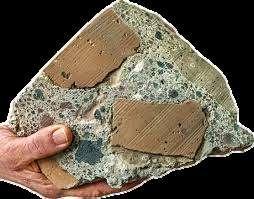
The mixture also includes a type of volcanic ash from Pozzuoli, Italy, which reacts with seawater and actually strengthens the structure over the years So structures near the sea, instead of just eroding, would become even more secure The special mixture was also more environmentally friendly. It took less energy to heat and left a much smaller carbon footprint than our modern-day process
So, why not use this amazing concrete today?
There are some drawbacks to the Romans’ magical concoction. One, it takes a longer time to set, meaning construction wouldn’t be as fast Also, because the concrete relied on time to strengthen it, it likely wouldn’t be able to withstand our modern uses for it in its first years Lastly, we don’t exactly know the details of the ancient recipe enough to replicate it, and the volcanic ash is from a very specific location, making it not readily available enough The special concrete could be useful, though. If scientists can unlock the full potential of Roman concrete, it may revolutionize sustainable construction in the future.
& CULTURE
EAMUS AD CINEMAM ROMANAM

“ If you want to change up the routine or just relax with your Latin-loving friends, I have an idea for you! Let’s go to Cinema Romana!”
“We just had a class trip to the movies,” said a kid holding a goose while celebrating Saturnalia “We saw Gladiator II!” I couldn’t believe my ears Lucky Haverfordians! No wonder they’re all so happy! Who wouldn’t want to watch such an epic movie, surrounded by people who “speak” the same lingo as you? Add some popcorn, and you’ll feel as if you’re sitting on a cement bench at the Colosseum.
Finally, the movie has come out and is available for rent What can I say? Firstly, it was awkward that the names of real Roman emperors were used in a completely fictional plot. So if you have any knowledge or an opinion about them, your nature will rebel against the wrongful use of these figures from the past
Secondly, just like “Live long and prosper” takes you straight to Star Trek and “This is the way” to The Mandalorian, “Vae Victis” should immediately bring to mind Brennus mocking the defeated Romans. But in the movie, this phrase was used to symbolize Roman virtues. Non bene est!
Overall, if you want to see how Roman ships operated, how cruel some emperors were, and get a good feel for the Colosseum SPECTATE ID!
Maya Gavrin is a 10th-grade Latin student at Harriton High School and is an avid Certamen player and explores her fascination with mythology
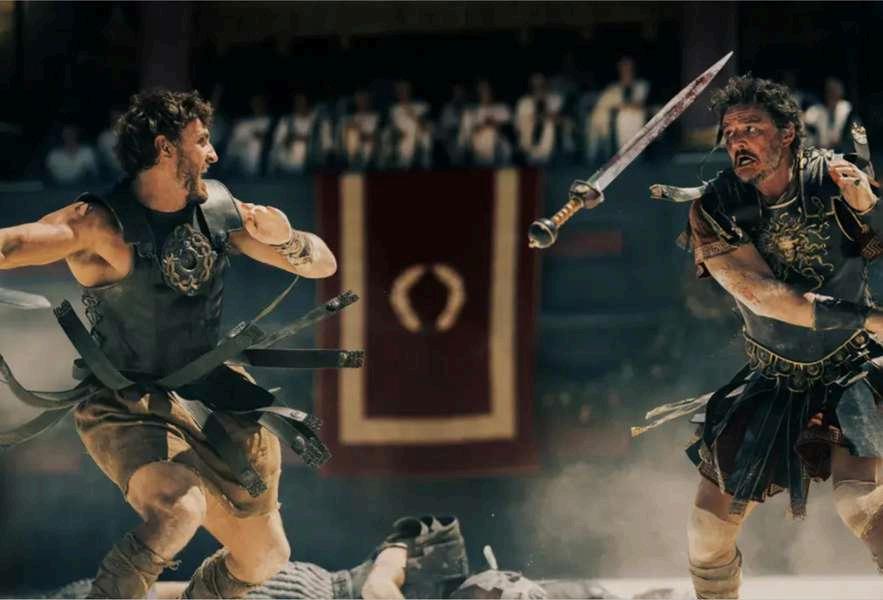
LIFESTYLE & CULTURE
WHY TAKE LATIN? REASONS LIST
For bragging rights – Because Caecilius est in horto sounds way cooler than "the guy is in the garden "
To impress your friends with obscure Latin phrases they didn’t know they needed – “Carpe noctem!”
To summon demons or curses – Let’s be honest: Latin spells just sound scarier.
To pretend you’re smarter than you are – Knowing carpe diem gets you instant philosopher vibes
Because Reddit and TikTok said it “looks good on college applications,” And who are we to argue with the algorithm?
To secretly understand Harry Potter spells – Admit it, you feel superior knowing Lumos means “light.”
To decode treasure maps or ancient tombs – Always be prepared… in case you stumble across buried treasure or a mummy’s curse
To win every argument about grammar – “Well, in the original Latin ” is a great way to sound 85% more correct.
To be part of the Roman Empire TikTok trend – Thinking about it daily doesn’t count unless you can do it in perfect passive participles
To know uncommon SAT words – "Magnanimous"? You already know Magnus means “great,” and animus means “spirit.”
Rebecca Zhao is a Latin IV student at North Allegheny High School
DEATH & Remembrance IN ANCIENT ROME
The Romans, unlike many people today, had a remarkable familiarity and even comfort with death and remembrance Death played a central role in their culture, evident in the popularity of gladiatorial combat and the numerous memorials lining Roman roads. Yet, despite its prevalence, death was understood and approached in varying ways. Wealthy families often honored their loved ones with elaborate tombs designed to reflect the glory of the deceased’s life, creating an eternal monument not unlike today’s memorial services, though intended to last forever
Roman mourning customs were also far more structured than modern ones There were strict expectations regarding how individuals should present themselves during a period of grief. Men who normally shaved were expected to grow out their beards, while women left their hair loose and unwashed physical signs of mourning that conveyed emotional distress However, both excessive and insufficient displays of grief were frowned upon and could provoke public judgment or even social consequences
Funerals were considered a vital rite of passage, symbolizing the transition from life to death. These ceremonies often featured music and hired mourners professionals who cried loudly and tore at their hair to visibly express sorrow Despite the somber tone, funerals concluded with a feast This communal meal marked not only the loved one's journey to the underworld but also the beginning of healing for the family left behind.

A REVIEW OF EPIC: THE MUSICAL

“It doesn’t just retell the Odyssey—it reclaims it, reshapes it, and sets it on fire with modern emotion.”

If you love Greek mythology and you’ve been on the internet in the past few months, there’s a good chance that you have heard of Epic: The Musical Epic is a concept album for a musical about the Odyssey, written and sung by Jorge Rivera-Herrans. Singers for the album auditioned on TikTok for their roles The way that the project came together is very cool, but is it worth listening to? This is my personal review of Epic: The Musical based on both the music and the story
As far as the actual story goes, it closely follows the Odyssey while also molding the story to fit a modern audience. Epic is much more character driven than the Odyssey is, and it places more emphasis on Odysseus’ personal journey than on the world around him. Some events are ordered a bit differently, and some conversations from the Odyssey are not included, but the story is told well within the forty songs that make up the concept album. The songs are split up into sagas (mostly for the sake of releasing them in increments as they were ready) that detail different parts of the story. For example, The Circe Saga is all about Odysseus trying to rescue his men from the sorceress Circe
The Thunder Saga is my favorite The characterization is very good The characters have incredibly detailed arcs in impressively short songs All in all, the Odyssey is recognizable, but the details are what make Epic its own form of media.
Musically, I found the motifs to be the most enjoyable part of the album. Songs like Just A Man, Suffering, and Open Arms have melodies that are referenced in many of the other songs Characters such as Penelope and Telemachus have their own musical motifs so that they can be represented even when they’re not physically there As a concept album, Rivera-Herrans and the cast of Epic have done a very good job of making the story understandable through music alone One complaint that some people have shared is that later songs are very reminiscent of music from anime, which conflicts with the tone of the overall album I hear the influence through the musical choices, but my opinion is that as the composer Rivera-Herrans is allowed to include artistic choices inspired by his interests. They aren’t my favorite songs, but they are fun
All in all, Epic: The Musical is a phenomenal project put together through hard work, talent, and astonishing creativity If you like Greek mythology, great voice acting, and a vivid retelling of a classic piece of literature, it is worth listening to
MODERN & COMPARISONS
HOW THE ROMANS LAUGHED:
ANCIENT HUMOR VS. MODERN MEMES

Latin may no longer dominate daily speech, but one language transcends time: humor From sarcastic Roman poets to modern-day memes, humanity’s ability to laugh at life’s absurdities proves that some things never change
BUT WHAT DID ROMANS
FIND FUNNY, AND HOW DOES IT COMPARE TO THE JOKES
WE SHARE TODAY?
Society has always been a significant focus for the entertainment industry. The complexities of a sophisticated society ultimately create absurdities - moments of irony, humor, and bizarreness - which have become an exploit for those looking to find a silver lining Whether it be pop culture, human habits, or politics (which God knows we’ve seen enough of recently), the potential is endless
This basic truth was captured by no one better than Ovid, a Roman poet born during the transition from the Republic to the Empire. Ovid, born into nobility, had a knack for orating and writing poetry Therefore, after abandoning public service to pursue literary arts, Ovid produced a wide array of masterpieces ranging from tragedies to elegiac couplets. However, his claim to fame is none other than his satirical works In pieces such as Metamorpheses and Ars amatoria, Ovid used a refreshingly sarcastic yet witty style with a dark sense of humor to criticize and commentate on the social attitudes of the time, whether it be romance, royalty, or masculinity This form of satire lives on today through mass media Witty critiques of culture have once again been popularized by talk show hosts such as Stephen Colbert and Jon Stewart, known for their vibrant, sardonic portrayals of major talking points In this sense, Roman and modern satire have more in common than one would expect, proving that despite how much the world changes, humans will always find a way to poke fun at the absurdities of society
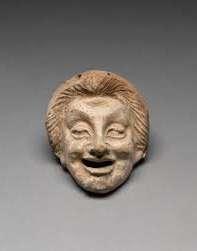
When most people associate Rome with slapstick comedy, they probably first think of Monty Python’s The Life of Brian As relevant (and hilarious) as it is, Rome’s ties to common, whimsical comedy don’t end there. Plautus, one of the most accredited playwrights in Roman history, proves that this style of entertainment is a fundamental part of the human palette, spanning far beyond Hollywood’s greatest creations.
Plautus, taking inspiration from Greek tales, developed a new way of portraying stories, transforming the products of Philemon and Menander into tales that were so much greater By taking significant liberties with his reconstruction of ancient plots and with his rather vulgar and low-brow sense of humor, Plautus established himself as one of the greatest entertainers in Roman history, redefining the very essence of theatre
“I’M SORRY
TO HEAR YOU ARE DEAD, AND SO, GOODBYE!”
This type of artistry experienced a revival within the 20th Century, as the increasing accessibility of film gave birth to a new era of entertainment. Filmmakers such as Monty Python and Mel Brooks used many of the same styles as Plautus to pioneer the genre of on-screen comedy, with movies such as Mel Brooks' Frankenstein retelling old tales with a new playful idea of humor. Though separated by thousands of years of shifting trends, the slapstick comedy of artists such as Mel Brooks and Plautus is deeply intertwined - not by inspiration, but by the nature of humor itself
If the entirety of 21st-century humor could be defined with one word, it would be “meme ” Memes, first defined in 1976 by Richard Dawkins as a product of cultural trends and duplication, have become the lifeblood of modern entertainment. As the internet has expanded, new jokes, habits, and cultural icons have spread like wildfire, reshaping the way humans interact to build a more authentic understanding of our habits. As archaeologists continue to unearth the ruins of Roman society, the discovery of graffiti has provided insight into how similar Romans were to modern people
Small notes have been found tagging the walls of temples and colosseums, such as jokes like, “Pyrrhus to his chum Chias: I’m sorry to hear you are dead, and so, goodbye!” and “O, Epaphras, thou art bald!” Upon reading these, one could wonder if they were taken from Rome or written out in some comment section on a YouTube video from 12 years ago Much like photographic memes, imprints and sketches were often left to either describe or insult the people and places around them While many Roman humorous sketches have been discovered, some contained adult content unsuitable for this publication. At the end of the day, these artifacts serve as a testament to the continuity of human humor No matter how advanced we become as a civilization, crude jokes and comments will always remain deep in our hearts
Humor is not merely a product of circumstance The jests of the day are as natural as our basic instincts to congregate and collaborate Despite the tests of time, humanity has proven that the language of laughter is truly universal and uniting, spanning far beyond class, dialect, creed, and era So the next time you hear a joke that you can’t help but giggle at, think, “I wonder if Cato, Caesar, or Plautus would be laughing with me.”
Brian Lester is a junior at Upper Dublin High School in Fort Washington, PA, currently enrolled in Latin IV Honors. A dedicated Latin scholar since 7th grade, Brian has had his work published in Torch US and is an inducted member of the Order of the Arrow, Scouting America’s honor society, which recognizes service and leadership through a selective election and initiation process. Looking ahead, Brian aims to deepen his understanding of diverse belief systems, philosophies, and schools of thought.

72ndAnnual
National Junior Classical League Convention
July 21-26, 2025 | Miami University, Oxford, Ohio
Nonscholaesedvitaediscimus. Welearnnotforschoolbutforlife. DerivedfromSeneca
AgendaandConventionevents
LiliaAitSahlia,NJCLPresident|president@njcl org
ElizabethBouis,ConventionAdvisor|convention@njcl org
UniversityandLocalMatters
AmyElifrits,ConventionCo-Chair|abelifrits@yahoo com
EmelieInderhees,ConventionCo-Chair|inderhees@wellington org
ToddWegenhart,ConventionCo-Chair|programs@njcl.org
FORREGISTRATION NATIONALJUNIORCLASSICALLEAGUE 860NWWashingtonBlvd,SuiteA Hamilton,OH45013 P 513-529-7741|F 513 529 7742|njcl org
SherwinLittle ConventionRegistrar littles@aclclassics org P 513-529-7741|F:515-529-7742
Registration Opens March1,2025
Cost:TBA

INFORMATION njcl org/NJCLConvention/2025NJCL-Convention
ICARUS AND THE EDGE OF SPACE
Icarus stood on the threshold of the aircraft, teetering on the edge of space The endless void seeped into every corner, like an onyx blanket wrapped infinitely around all of the universe. The silence was stale and claustrophobic, nonetheless, Icarus loved it. The grandness of space made him feel free from all the obligations and expectations from his father, Daedalus Icarus was young and filled with spirit and the eagerness to prove himself. Growing up, he experienced firsthand his father's supreme intelligence, which fostered deep insecurities within himself Unlike his father, Icarus was not brilliant and felt the pressure of others' expectations to be a prodigy like Daedalus. Icarus had joined the space agency to make his father proud and move out of his shadow What he didn’t realize was that his desperation for Daedalus’ validation blinded him from seeing his father’s true feelings of unconditional love. Striving recklessly to be accepted would ultimately be the cause of Icarus’s demise
Daedalus, a cautious man, was the opposite of Icarus. He was well-seasoned in life and had experienced many trials and tribulations, as well as deep regret He was haunted by the blood on his hands from the attempted murder of his nephew, Talos Talos had been learning under Daedalus and quickly started to overshadow him in intelligence Daedalus began to fear that he would become the former genius of Athens, and Talos’ reputation would eclipse his Daedalus was driven by insecurity and jealousy to push his nephew off the cliff of the Acropolis. Talos survived the treacherous incident and, so scarred by the experience, devoted himself to becoming a pilot for the rest of his life, determined to master the very force that had nearly killed him.

Daedalus was tried for his actions and banished from Athens To escape his past, he found refuge in Crete, where he met Icarus' mother, Naukrate, who was a servant for the president Minos. Daedalus hoped that he would be able to raise his son not to make the same mistakes he had made as a young man Soon after settling in Crete with his new family, Daedalus and Minos became close companions Minos was highly impressed with Daedalus's intelligence and creativity and invited him to join the Italian Space Agency There, Minos tasked Daedalus with a special project, designing a maze in space meant to contain a horrible monster called the Minotaur. Created in a lab for the research of genes and DNA, the minotaur was a mutated creature with the body of a man and the head of a bull The head of the bull could only scream, no longer able to speak the human language, and while it had the physique of a man, it was as strong as an animal The experiment had gone wrong and led to an accident with Mino's wife, Pasiphae The Minotaur had broken out of the lab and had targeted Pasiphae, injuring her severely.
Minos didn’t want to kill the Minotaur but wanted to keep it trapped in a maze in space so that it would never be able to hurt his wife again Daedalus had agreed to build such a labyrinth. Little did he know that Minos had planned to double-cross him and throw him and his son Icarus into the maze as well
Icarus had taken a deep breath and smiled. His father, having already jumped, was waiting for him This was the day they were finally escaping the labyrinth with the brilliant contraptions his father had built them A solar glider consisting of overlapping metal tiles like the feathers of a bird would power them through space to the closest space station
Knowing of the dangers, Daedalus had carefully tethered themselves to the ship containing the maze as they jumped into the void He was determined to free Icarus from the labyrinth and keep him safe. Once they reached another space station, they could start a new life While instructing Icarus, Daedalus had stressed not to put excessive force on the tether or overexert the gliders However, his warning fell on deaf ears. Icarus took a running leap out into the void. His body floated effortlessly into space, his eyes wide as he took in the dangerous beauty of the solar system Icarus was eager for his first space walk so that he could prove to his father that he was brave and capable. Out of paternal love, Daedalus called out to remind him again of the importance of the tether, but Icarus heard his words as a rebuke instead


The tether had felt like a restraint, like training wheels, like his father didn't trust him, didn't believe that he could do it on his own. Icarus released the tether. Unencumbered by his father's restrictions, he flew as fast as he could, the solar glider shimmering and shuddering under the strain His father's cries of fear were not heard through the adrenaline pumping through his ears. He knew his father was watching him now, seeing his strong and confident flight The gliders were not meant to withstand the speed Icarus was challenging them Instantly, a deafening crack sounded, and Icarus's smile dropped from his face
“His body floated effortlessly into space, his eyes wide as he took in the dangerous beauty of the solar system.”
He screamed his father's name, but it was too late. The solar glider broke apart, the metal tiles scattering like feathers Daedelus was too far to reach his son Icarus was lost and alone forever, floating through the endless space. Only now did Icarus recognize the love behind his father's warnings, but the realization came too late. All of Daedalus’ plans had been for him, and that he had been his father's greatest pride Though they had escaped the maze, they left behind the Minotaur, forever trapped in the labyrinth of space. Daedalus had fulfilled his commission, even if not in the way Minos had intended
Like the myth, this retelling reminds us that ambition without caution can lead to a fall, even among the stars.
HTTPS://TINYURL COM/PAJRCL
STATE OFFICERS
PRESIDENT
ROHA HERIAL
VICE PRESIDENT
SABRINA BAUER
SECRETARY
CHRISTOPHER CHANG
PARLIAMENTARIAN
SOHUM BANDYOPADHYAY
EDITOR
EMMANUELLE KRAMER
CHAIRPERSON
RYAN ZEITZER COMMUNICATIONS
QUINN MCINTIRE CONSTITUTION
KARIN SUZADIIL TECHNOLOGY
TRACI DOUGHERTY
TREASURER
KARIN SUZADIIL PROGRAMS
SARA FLOUNDERS PUBLICATIONS
TRACI DOUGHERTY
KEYSTONE
is the official publication of the Pennsylvania Junior Classical League (PAJCL) It serves as a platform to inform, inspire, and connect members through engaging content that celebrates the study of Latin, Greek, and classical civilizations
Featuring chapter news, event recaps, contest results and student submissions including educational articles, artwork and more. The Keystone highlights the achievements and voices of PAJCL members while fostering a shared love for the classics.

WHY JOIN?
Joining the Pennsylvania Junior Classical League (PAJCL) offers students a wealth of opportunities to engage with Latin, Greek, and classical civilizations in meaningful and exciting ways.
Through leadership roles, service projects, and participation in events like the annual PAJCL Convention, members develop valuable skills in teamwork, communication, and organization. Our vibrant community of like-minded peers, allows students to build friendships and connections across the state
For those who seek to deepen their passion for the classics, PAJCL offers a keystone to learning, leadership, and lifelong inspiration

